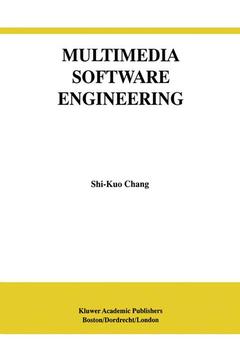Description
Multimedia Software Engineering, 2000
International Series in Software Engineering Series, Vol. 7
Language: English
Subject for Multimedia Software Engineering:
Multimedia Software Engineering
Publication date: 10-2012
238 p. · 15.5x23.5 cm · Paperback
Publication date: 10-2012
238 p. · 15.5x23.5 cm · Paperback
Multimedia software engineering (Kluwer intl series in software engineering 7)
Publication date: 01-2000
238 p. · 15.5x23.5 cm · Hardback
Publication date: 01-2000
238 p. · 15.5x23.5 cm · Hardback
Description
/li>Contents
/li>
Multimedia has two fundamental characteristics that can be expressed by the following formula: Multimedia = Multiple Media + Hypermedia. How can software engineering take advantage of these two characteristics? Will these two characteristics pose problems in multimedia systems design? These are some of the issues to be explored in this book.
The first two chapters will be of interest to managers, software engineers, programmers, and people interested in gaining an overall understanding of multimedia software engineering. The next six chapters present multimedia software engineering according to the conceptual framework introduced in Chapter One. This is of particular use to practitioners, system developers, multimedia application designers, programmers, and people interested in prototyping multimedia applications. The next three chapters are more research-oriented and are mainly intended for researchers working on the specification, modeling, and analysis of distributed multimedia systems, but will also be relevant to scientists, researchers, and software engineers interested in the systems and theoretical aspects of multimedia software engineering.
Multimedia Software Engineering can be used as a textbook in a graduate course on multimedia software engineering or in an undergraduate course on software design where the emphasis is on multimedia applications. It is especially suitable for a project-oriented course.
The first two chapters will be of interest to managers, software engineers, programmers, and people interested in gaining an overall understanding of multimedia software engineering. The next six chapters present multimedia software engineering according to the conceptual framework introduced in Chapter One. This is of particular use to practitioners, system developers, multimedia application designers, programmers, and people interested in prototyping multimedia applications. The next three chapters are more research-oriented and are mainly intended for researchers working on the specification, modeling, and analysis of distributed multimedia systems, but will also be relevant to scientists, researchers, and software engineers interested in the systems and theoretical aspects of multimedia software engineering.
Multimedia Software Engineering can be used as a textbook in a graduate course on multimedia software engineering or in an undergraduate course on software design where the emphasis is on multimedia applications. It is especially suitable for a project-oriented course.
1. A Framework for Multimedia Software Engineering.- 2. Perspectives in Multimedia Software Engineering.- 3. Syntax: Visual Languages.- 4. Syntax: Multimedia Languages.- 5. Semantics: The Active Index.- 6. Semantics: Teleaction Objects.- 7. Pragmatics: Tools for a Multimedia Development Environment.- 8. Pragmatics: Prototyping Multimedia Applications.- 9. Systems: The Design of Multimedia Languages.- 10. Systems: Distributed Multimedia Systems Design.- 11. Systems: The Specification of Multimedia Applications.- 12. Exercises and Project Suggestions.- References.
© 2024 LAVOISIER S.A.S.




